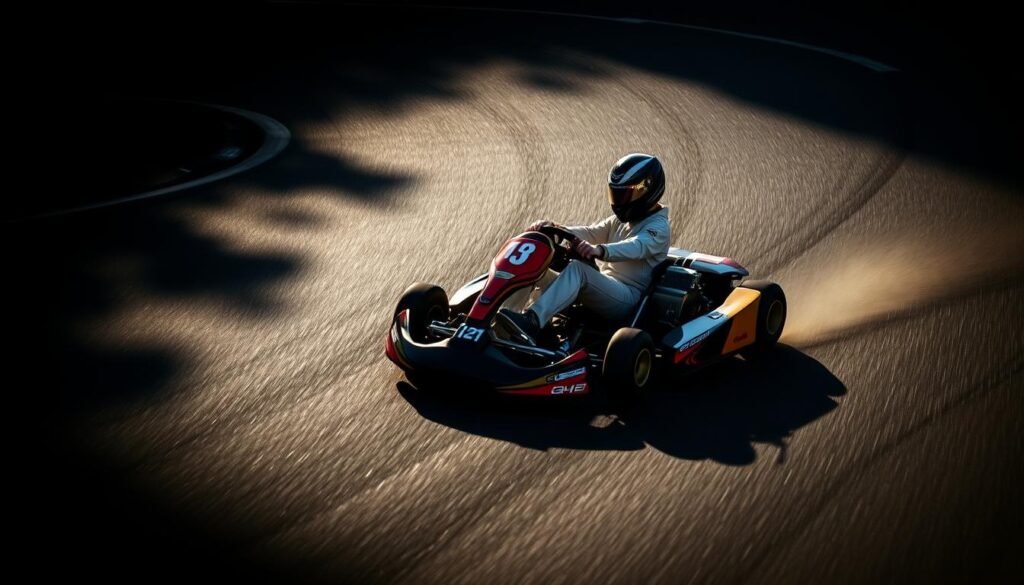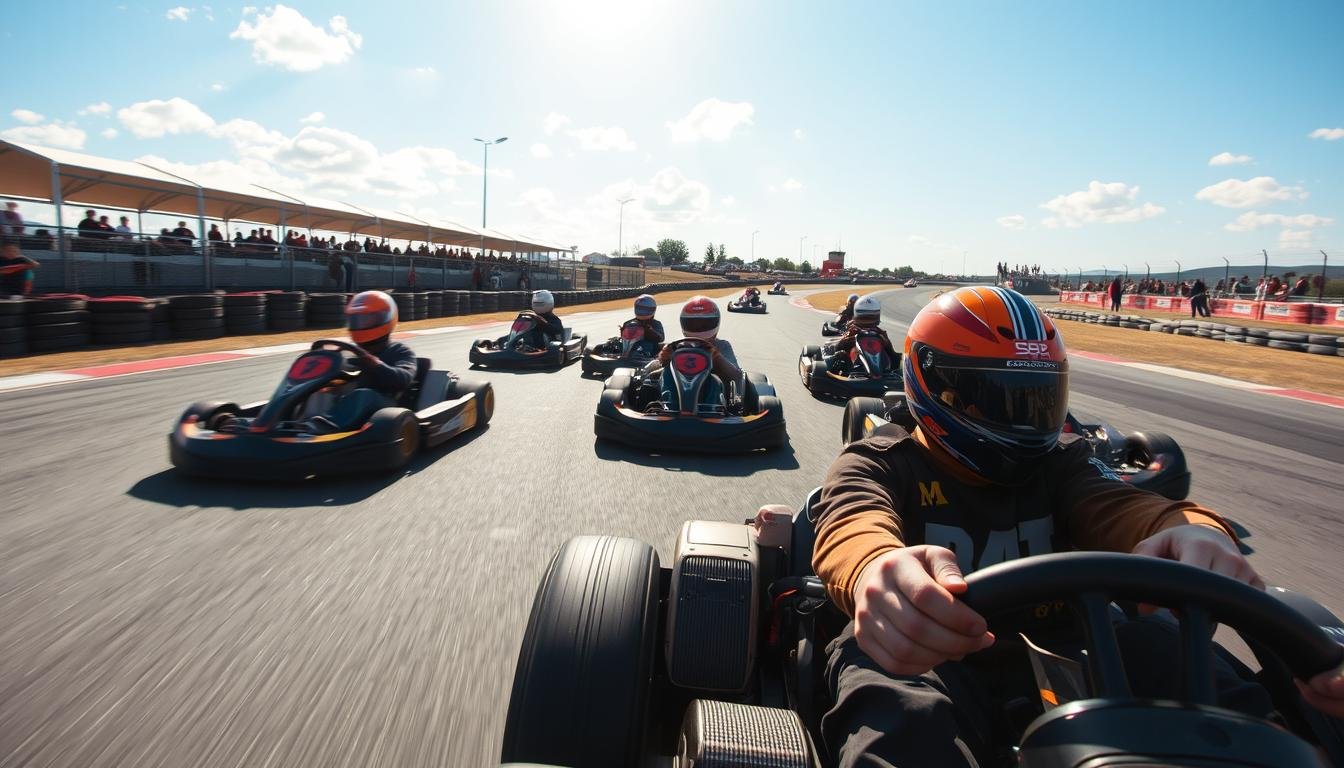Stepping onto the track for the first time can feel like diving into a high-speed chess match. Karting demands quick reflexes, smart strategy, and razor-sharp focus. Yet many new racers unknowingly sabotage their progress through easily fixable errors.
This guide breaks down the critical missteps that stall early progress. From improper seat positioning to oversteering, small choices have big impacts on lap times. We’ll show how refining these details can transform frustration into confidence.
Proper preparation separates casual drivers from serious competitors. Learning to read track conditions and master weight distribution creates immediate advantages. Our actionable tips help build skills faster while sidestepping costly trial-and-error phases.
Key Takeaways
- Pre-race vehicle checks prevent mechanical issues during crucial moments
- Smooth steering inputs maintain better control than aggressive movements
- Braking zones require precise timing to avoid spinouts
- Track temperature affects tire grip more than most realize
- Consistent practice sessions build muscle memory faster
Introduction to the Thrill of Go-Karting
From the first turn of the wheel, karting delivers a pure form of motorsport accessible to all. Unlike traditional racing series, it strips away complex technology and focuses on raw driver skill. This simplicity creates an electrifying racing experience where every decision impacts your position.
Overview of Karting and Its Appeal
Karting thrives as a gateway to competitive motorsports. Its low-cost entry and minimal equipment needs attract diverse enthusiasts. Families enjoy weekend sessions, while aspiring pros use it to hone reflexes and racecraft. The sport’s versatility allows casual fun or intense competition, depending on your goals.
Why Error Prevention Enhances Performance
Early missteps can derail progress in ways new drivers rarely anticipate. Oversteering or improper braking doesn’t just slow lap times—it risks collisions and lost confidence. Mastering fundamentals like weight distribution and cornering lines transforms chaotic runs into controlled, repeatable success.
Seasoned instructors emphasize one truth: “Speed follows control.” Prioritizing technique over aggression builds a foundation for consistent improvement. This mindset separates fleeting excitement from lasting mastery in the sport.
Understanding the Fundamentals of Karting
Mastering karting starts with decoding its invisible pathways. Every circuit hides patterns that separate fast laps from frustrating ones. The secret lies in track dynamics and how drivers interact with them through precise movements.
Breaking Down the Racing Line and Track Dynamics
The racing line acts as your kart’s GPS for speed. It guides you through three phases: entering wide, clipping the apex, and exiting toward the track’s outer edge. This path minimizes steering adjustments while maximizing momentum.
Track surfaces and elevation changes demand constant adaptation. A bumpy corner might require earlier braking, while uphill sections let karts carry extra speed. Professionals often say: “The ideal line shifts with the sun’s position” due to temperature affecting tire grip.
Key Principles for Safe and Efficient Driving
Balance defines great karting. Push too hard, and you’ll slide wide; drive too cautiously, and rivals will pass. Focus on these essentials:
- Adjust throttle input mid-corner to maintain traction
- Brake in straight lines before turning
- Use your body weight to influence the kart’s balance
Consistency beats heroics. Smooth steering inputs create predictable handling, letting you build speed lap after lap. Remember: understanding racing line principles transforms chaotic runs into calculated performances.
Common Mistakes Beginners Make in Go-Karting (and How to Avoid Them)
Navigating the karting track requires precision, yet many newcomers stumble on basic techniques. Steering errors top the list of common karting mistakes, with drivers shifting hand positions mid-turn. Keeping hands fixed at 9 and 3 o’clock improves control and reduces overcorrections.
Braking habits also derail progress. Novices often press pedals too gently, delaying full stops. “Aggressive braking in straight lines prevents wheel lock,” advises pro racer Tyler Johnson. Pair this with gradual acceleration to maintain grip through corners.
Track awareness separates rookies from veterans. Many cut turns too early, missing apexes that preserve speed. Use every inch of the racing surface—enter wide, clip the inside curb, and exit toward the outer edge.
- Avoid blaming equipment: Focus on refining skills before tweaking setups
- Warm tires properly: Two practice laps optimize rubber grip
- Scan ahead: Eyes should target exit points, not immediate obstacles
Consistency beats raw speed in early stages. Smooth throttle inputs and deliberate steering create repeatable lap times. Master these fundamentals to transform karting mistakes into strategic improvements.
Critical Techniques for Better Karting Performance
Precision driving separates karting champions from weekend warriors. Small adjustments in steering technique and braking control create measurable differences in lap times. This section breaks down the mechanical skills that transform erratic driving into calculated performance.
Proper Hand and Steering Techniques
Your hands act as the kart’s command center. Grip the wheel at 9 and 3 o’clock—this position maximizes leverage during sharp turns. Avoid shuffling your palms mid-corner; locked wrists provide steadier inputs.
“Steering isn’t about force—it’s about finesse,” explains NASCAR instructor Rachel Black. Jerky movements upset the chassis, while smooth rotations maintain traction. Practice minimal wheel adjustments—most corners require less than 90 degrees of rotation.
Optimizing Braking and Acceleration
Braking technique determines corner entry speed. Press the pedal firmly until tires near lock-up, then ease pressure as you approach the turn. This “squeeze-and-release” method prevents skidding while preserving momentum.
Acceleration demands similar discipline. Wait until the kart straightens before flooring the throttle. Sudden power bursts during turns cause wheel spin—a costly error when milliseconds matter.
- Use peripheral vision to monitor wheel alignment
- Shift body weight forward during hard braking
- Match throttle input to steering angle
Maximizing Track Use and Cornering Strategy
The art of cornering defines race outcomes more than straight-line speed. Perfecting your approach to turns unlocks hidden time gains across every lap. Drivers who hit apex points consistently while using the full track width create unbeatable momentum.

Understanding Apex and Exit Speeds
Every corner has two critical markers: the apex and exit. The apex marks where your kart’s inside wheels graze the turn’s tightest point. Hitting it allows higher entry speed without sliding wide.
Exit speed matters most. “A fast exit trumps early acceleration,” says IndyCar coach Marco Rossi. Focus on aligning wheels early to maximize throttle application. This builds velocity for upcoming straights.
Adjusting to Different Track Layouts
Tight circuits demand late apexes to straighten exit paths. High-speed tracks reward early apexes that maintain flow. Study these patterns during practice laps:
- Technical tracks: Prioritize exit alignment over entry speed
- Flowing layouts: Link corners using momentum-preserving lines
- Mixed surfaces: Adapt apex points based on grip levels
Always use the track’s outer edges during entry and exit. This widens your turning radius, letting you carry more speed through bends. Master these adjustments to transform track knowledge into lap-time advantages.
Perfecting Kart Setup and Equipment Feedback
Your kart speaks through vibrations and handling quirks – learning its language separates good drivers from great ones. Effective teamwork begins with translating physical sensations into precise technical terms. Crew chief Mia Torres notes: “A driver saying ‘it feels loose’ tells me nothing. ‘Oversteer exiting Turn 3’ lets me adjust rear tire pressure.”
Communicating with Your Crew
Build a shared vocabulary describing specific behaviors. Does the front push wide (understeer) or the rear slide out (oversteer)? Note when issues occur – during acceleration, braking, or mid-corner. Track performance improves when mechanics receive actionable data, not vague complaints.
Fine-Tuning Kart Adjustments for Better Control
Small changes create big results. Lowering tire pressure 1 PSI increases grip on cold tracks. Moving your seat forward shifts weight distribution for tighter turns. Stiffer chassis settings help maintain control on bumpy circuits.
Make sure to test one adjustment per session. Changing multiple variables clouds cause-effect relationships. Record lap times after each modification – numbers don’t lie. This systematic approach transforms guesswork into calculated improvements.
Essential Safety Gear and Protective Equipment
Safety equipment forms the invisible shield between drivers and track hazards. High-quality gear transforms reckless risks into calculated competition. Every component serves a purpose – from impact absorption to maintaining control during split-second decisions.
Helmet, Neck Brace, and Rib Protector Basics
A certified helmet remains non-negotiable. Look for SNELL SA2020 or CIK-FIA approvals – these standards guarantee impact resistance. Proper fit prevents shifting during sudden movements. Pair it with a neck brace that limits whiplash without restricting vision.
Rib protectors combat side impacts during tight cornering. Modern designs use flexible foam layers that absorb shocks while allowing breathing room. Ensure your seat positioning accommodates these guards without compromising steering range.
Choosing the Right Gloves, Boots, and Karting Suits
Kart-specific gloves feature reinforced palms for steering grip and vibration dampening. Seamless finger construction prevents blisters during long sessions. Match them with boots using ultra-thin soles – you’ll feel pedal textures better for precise throttle control.
Race suits should withstand 40-foot slides on asphalt. Multi-layer fabrics with Kevlar stitching offer maximum abrasion resistance. Remember: “Safety gear works as a system – weak links compromise everything,” notes NASCAR safety engineer Laura Chen.
Routine Maintenance Tips for Your Go-Kart
Consistent upkeep transforms your kart from a temperamental machine to a reliable racing partner. Proper care preserves peak performance while preventing mid-session breakdowns that ruin race days.
Cleaning, Lubrication, and Brake Checks
Wash your kart after every session using low-pressure water. Dirt buildup on chassis components creates drag and masks potential cracks. Dry thoroughly to prevent rust in critical areas.
Lubricate the drive chain while it’s warm for better penetration. Apply grease to axle bearings monthly, rotating wheels to distribute evenly. Sticky bearings rob speed and strain engines.
Test brakes before each outing. Squeeze the pedal – spongy resistance means air in the lines. Replace pads when thickness drops below 3mm. Worn pads increase stopping distances, costing precious lap time.
Inspection of Chassis, Tyres, and Mechanical Parts
Scan the frame for stress fractures near weld points. Use a flashlight to check hidden tubing sections. Even hairline cracks can escalate during hard cornering.
Check tyre pressures when rubber is cold. Underinflation causes sidewall flex, while overinflation reduces grip. Look for uneven wear patterns indicating alignment issues.
Tighten all bolts to manufacturer specs using a torque wrench. Vibrations loosen connections over time. Pay special attention to steering components and engine mounts.
Pre-Race Strategy and Event Planning
Race day success begins long before engines roar. Champions emerge from meticulous preparation that blends mechanical readiness with razor-sharp focus. Treating every detail as a performance multiplier separates podium finishers from grid backmarkers.
Preparing Your Kart and Mental Readiness
Top-tier performance starts with a race-ready machine. Create a 15-point checklist covering tire pressure, brake pad thickness, and chain tension. Mechanics recommend completing inspections 48 hours before events to allow time for adjustments.
Mental preparation proves equally critical. Visualization techniques help drivers rehearse challenging corners and overtaking scenarios. “Walk through each lap in your mind before sleeping,” advises 3-time champion Derek West. This builds neural pathways for faster track reactions.
Understanding Race Organization and Track Walks
Arrive early to decode event logistics. Study the schedule for practice sessions, qualifying rounds, and mandatory briefings. Many races enforce strict tech inspections – make sure your kart meets all safety regulations.
Track walks reveal hidden opportunities. Note these elements during reconnaissance:
- Surface changes affecting braking zones
- Curbs that can be ridden for faster exits
- Marshaling post locations for emergency signals
Combine this intel with weather forecasts to adapt your strategy. Wet tracks demand different tire choices and racing lines than dry conditions. Consistent practice in varied environments builds versatile skills for any scenario.
Fitness and Nutrition: Boosting Karting Performance
Physical conditioning separates contenders from pretenders in high-G environments. While karting appears less demanding than full-scale racing, sustained lateral forces test muscle endurance and mental clarity. Proper training and fueling strategies turn physical limitations into competitive advantages.
Strengthening Core and Neck Muscles for Endurance
Core stability maintains precise steering control during prolonged sessions. Plank variations and rotational exercises build torso resilience against cornering forces. Neck strengthening using resistance bands combats fatigue from helmet weight and vibration.
Optimizing Diet and Hydration for Peak Performance
Race-day nutrition focuses on sustained energy release. Complex carbs like oatmeal provide gradual fuel, while bananas prevent muscle cramps. Hydration begins 48 hours pre-event – electrolyte mixes maintain nerve function better than plain water.
Avoid heavy meals within three hours of sessions. Small protein-rich snacks between heats aid recovery without digestive strain. Remember: “Your body performs like your kart – feed it premium fuel.”

Ramon Splinter is a passionate go-kart enthusiast and expert who shares valuable tips and insights on Zyorb, a blog dedicated to karting enthusiasts. With years of experience on the track, he specializes in helping beginners and seasoned drivers improve their skills, optimize their karts, and master racing strategies. His articles combine technical knowledge with practical advice, making go-karting more accessible and exciting for all.

